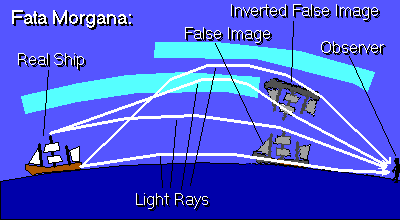

- Assume a fish is under water. As the fish moves, light travels different paths to reach your eye.
These angles are measured from the perpendicular to the surface of the water. What is angle of refraction in air?Angle in water
Angle in air
15
30
45
60
75
- Do objects in water appear higher or lower in the water than they really are?
Sketch the rays for this. - Did you find any angles where the light did not escape to the air?
- That is Total Internal Reflection. How is this used in fiber optics?
- Assume the object is in the air. For each angle, at what angle does the fish see it? (Again, the angles are measured from straight up.)
Angle in water
Angle in air
15
30
45
60
75
- Why don't fish have necks??!
(See Fish-eye view.)
Review Refraction Explanations.
Index for Refraction.
Andria Erzberger
2/1/01